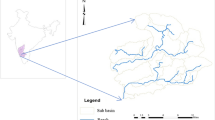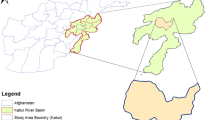Abstract
The semi-distributed SWAT model is widely used at the watershed scale. The objective of this study is to evaluate the capacity of the SWAT model to simulate the water balance components of the uncontrolled part of the Ichkeul watershed. This is done to predict the future flow out and impacts of urban facilities and climate change on the Ichkeul ecosystem. In addition, the risk of losing this strategic asset must be minimized. Various climatic (precipitation, temperature, wind speed, relative humidity, and solar radiation) morphological (DEM) and thematic data were used to feed the model. Through the SUFI-2 algorithm, SWAT-CUP performs the sensitivity and uncertainty analysis operation. For the time intervals of 2015–2017 and 2018–2019, the model was calibrated and validated by comparing simulated flows with observed flows at the Ecluse-Sidi Hassoun station located downstream of the study area. The quality of the daily simulated liquid flow predictions was evaluated using a performance evaluator (R2, NSE, PBIAS, P-factor, and R-factor). For the calibration and validation periods, NSE, PBIAS, P-factor, and R-factor were 0.87 and 0.93, -6.7 and 6.8, 0.97 and 0.95, 1.17 and 1.11, and finally 0.88 and 0.94 for R2. These findings demonstrate a good match between the measured outflow and the simulation. SWAT predicts outflows effectively. Thus, the outflow from the uncontrolled part of the Ichkeul watershed may be predicted using this model.









Similar content being viewed by others
Data availability
I declare the availability of data for this journal.
References
Abbaspour KC (2005) Calibration of hydrologic models: when is a model calibrated? In: Zerger A, Argent RM (eds) Proceedings of the International Congress on Modelling and Simulation (MODSIM’05). Modelling and simulation society of Australia and New Zealand, Melbourne, pp 2449–2455
Abbaspour KC (2007) User manual for SWAT-CUP, SWAT calibration, and uncertainty analysis programs. Swiss Federal Institute of Aquatic Science and Technology, Eawag
Abbaspour KC, Vejdani M, Haghighat S (2015) SWATCUP calibration and uncertainty programs for SWAT. In: Proceedings of the International Congress on Modelling and Simulation.
Abbott MB, Bathurst JC, Cunge JA, O’connell PE, Rasmussen J (1986) An introduction to the European hydrological system—Systeme Hydrologique Europeen, “SHE”, 2: structure of a physically-based, distributed modelling system
ANPE (1994) Rapport interne : Etude pour la sauvegarde du parc National de l’Ichkeul, 1ére partie : Collecte des données disponibles et analyse des études existantes : p 291
Ariza-Villaverde AB, Jiménez-Hornero FJ, De Ravé EG (2015) Influence of DEM resolution on drainage network extraction: a multifractal analysis. Geomorphology 241:243–254
Arnold JG, Allen PM (1999) Automated methods for estimating baseflow and groundwater recharge from stream flow records. J Amer Water Resour Assoc 35(2):411–424
Arnold JG, Srinivasan R, Muttiah RS, Williams JR (1998) Large-area hydrologic modeling and assessment: part I. Model development. J Am Water Resour Assoc 34(1):73–89
Arnold JG, Moriasi DN, Gassman PW, Abbaspour KC, White MJ, Srinivasan R, Santhi C, Harmel RD, Van Griensven A, Van Liew MW, Kannan N (2012) SWAT: model use, calibration, and validation. Trans ASABE 55(4):1491–1508
Ben Mammou A (2006) Aménagements hydrauliques des bassins exoréiques de la Tunisie. Impact sur le flux sédimentaire et la stabilité du littoral, No 30 - Fluxes of small and medium-size Mediterranean rivers: impact on coastal areas. Trogir, March, April 2006
Billen G, Garnier J, Rousseau V (2005) Nutrient fluxes and water quality in the drainage network of the Scheldt basin over the last 50 years. Hydrobiologia 540:47–67
Coffey ME, Workman SR, Taraba JL, Fogle AW (2004) Statistical procedures for evaluating daily and monthly hydrologic model predictions. Trans ASAE 47(1):59–68
Green WH, Ampt GA (1911) Studies on soil physics: 1. The flow of air and water through soils. J Agric Sci 4(1):11–24
Grusson MY (2015) Modélisation de l'évolution hydroclimatique des flux et stocks d'eau verte et d'eau bleue du bassin versant de la Garonne [Thèse de doctorat]. Institut National Polytechnique de Toulouse (INP Toulouse), p 36
Gupta HV, Sorooshian S, Yapo PO (1999) Status of automatic calibration for hydrologic models: Comparison with multilevel expert calibration. J Hydrologic Eng 4(2):135
Hargreaves GL, Hargreaves GH, Riley JP (1985) Agricultural benefits for Senegal River basin. J Irrig Drain Eng 111(2):113–124
HEC (Hydrologic Engineering Center) (2000) Hydrologic Modeling System HEC-HMS. User’s Manual, Version 2. Hydrologic Engineering Center; US Army Corps of Engineers, Davis
Henia L (1987) Climat et bilans de l'eau en Tunisie: essai de régionalisation climatique par les bilans hydriques
Holtan HN, Lopez NC (1971) USDAHL-70 model of watershed hydrology (No. 1435). Département de l'agriculture des États-Unis 87(1–2) :61–77
Hosseini SH, Khaleghi MR (2020) Application of SWAT model and SWAT-CUP software in simulation and analysis of sediment uncertainty in arid and semi-arid watersheds (case study: the Zoshk-Abardeh watershed). Model Earth Syst Environ 6:2003–2013. https://doi.org/10.1007/s40808-020-00846-2
ITES (2014) Tunisian Institute for Strategic Studie. Etude stratégique : Système hydraulique de la Tunisie a l’horizon 2030. Janvier, Tunis, Tunisia
Krause P, Boyle DP, Bäse F (2005) Comparaison de différents critères d’efficacité pour l’évaluation des modèles hydrologiques. Adv Geosci 5:89–97
Kumar N, Singh SK, Singh VG et al (2018) Investigation of impacts of land use/land cover change on water availability of Tons River Basin, Madhya Pradesh, India. Model Earth Syst Environ 4:295–310. https://doi.org/10.1007/s40808-018-0425-1
Li J, Wong DW (2010) Effects of DEM sources on hydrologic applications. Comput Environ Urban Syst 34:251–261
Luo Y, Baolin Su, Yuan J, Li H, Zhang Q (2011) GIS techniques for watershed delineation of SWAT model in plain polders. Procedia Environ Sci 10:2053p
Ma L, Ascough JC II, Ahuja LR, Shaffer MJ, Hanson JD, Rojas KW (2000) Root zone water quality model sensitivity analysis using monte carlo simulation. Trans ASAE 43(4):883–895
Meisels A, Raizman S, Karnieli A (1995) Skeletonizing a DEM into a drainage network. Comput Geosci 21:187–196
Monteith JL (1965) Evaporation and the environment. The state and movement of water in living organisms. In: 19th Symposia of the Society for Experimental Biology. Cambridge University Press, London, pp 205–234
Moriasi D, Arnold J, Van Liew M, Bingner R, Harmel R, Veith T (2007) Model evaluation guidelines for systematic quantification of accuracy in watershed simulations. Trans ASABE 50(3):885–900
Muthee SW, Kuria BT, Mundia CN et al (2022) Using SWAT to model the response of evapotranspiration and runoff to varying land uses and climatic conditions in the Muringato basin, Kenya. Model Earth Syst Environ. https://doi.org/10.1007/s40808-022-01579-0
Nash JE, Sutcliffe JV (1970) River flow forecasting through conceptual models: Part 1. A discussion of principles. J Hydrology 10(3):282–290
Neitsch SL, Arnold JG, Kiniry JR, Srinivasan R, Williams JR (2002) Soil and water assessment tool, user manual, version 2000. Grassland, Soil and Water Research Laboratory, Temple
Pereira LS, Cordery I, Iacovides I (2002) Coping with water scarcity. UNESCO IHP VI, Technical Documents in Hydrology No. 58, UNESCO, Paris, p 267
Pereira DR, Martinez MA, Pruski FF, da Silva DD (2016) Hydrological simulation in a basin of typical tropical climate and soil using the SWAT model part I: Calibration and validation tests. J Hydrol Reg Stud 7:14–37
Priestley CHB, Taylor RJ (1972) On the assessment of surface heat flux and evaporation using large-scale parameters. Mon Weather Rev 100(2):81–92
Refsgaard JC (1997) Parameterisation, calibration, and validation of distributed hydrological models. J Hydrol 198(1):69–97
Santhi C, Arnold JG, Williams JR, Dugas WA, Srinivasan R, Hauck LM (2001) Validation of the SWAT model on a large river basin with point and nonpoint sources. J Am Water Resour Assoc 37(5):1169–1188
Schuol J, Abbaspour KC, Srinivasan R, Yang H (2008) Estimation of freshwater availability in the west African subcontinent using the SWAT hydrologic model. J Hydrol 352(1–2):30–49
Sisay E, Halefom A, Khare D et al (2017) Hydrological modelling of ungauged urban watershed using SWAT model. Model Earth Syst Environ 3:693–702. https://doi.org/10.1007/s40808-017-0328-6
Sorooshain S, Gupta VK (1995) Model calibration. In: Singh VP (ed) Computers models of watershed hydrology. Water Resources Publication, Highlands Ranch, pp 23–63
Tarekegn N, Abate B, Muluneh A et al (2022) Modeling the impact of climate change on the hydrology of Andasa watershed. Model Earth Syst Environ 8:103–119. https://doi.org/10.1007/s40808-020-01063-7
U.S. Department of Agriculture, Soil Conservation Service (1972) National Engineering Handbook. Hydrology Section 4. Chapters 4–10. Washington: USDA
Van Griensven A, Bauwens W (2003) Multiobjective autocalibration for semidistributed water quality models. Water Resour Res 39(12):1348–1356
Van Liew MW, Arnold JG, Bosch DD (2005) Problems and potential of autocalibrating a hydrologic model. Trans ASAE 48(3):1025–1040
Van Liew MW, Schneider JM, Garbrecht JD., 2003, octobre. Streamflow response of an agricultural watershed to seasonal changes in precipitation. In: Proceedings of the 1st interagency conference on research in the watersheds (ICRW), pp 27–30
Acknowledgements
This paper is a contribution between The University of CARTHAGE (Faculty of Sciences of Bizerte) and the National Agency of Environment Protection (ANPE), and part of the PhD of the first author. We are grateful to the reviewer who contributed to the improvement.
Author information
Authors and Affiliations
Corresponding author
Additional information
Publisher's Note
Springer Nature remains neutral with regard to jurisdictional claims in published maps and institutional affiliations.
Rights and permissions
Springer Nature or its licensor (e.g. a society or other partner) holds exclusive rights to this article under a publishing agreement with the author(s) or other rightsholder(s); author self-archiving of the accepted manuscript version of this article is solely governed by the terms of such publishing agreement and applicable law.
About this article
Cite this article
Ben Saad, A., Ben M’barek-Jemai, M., Ben M’barek, N. et al. Hydrological modeling of the watershed of a RAMSAR site using the SWAT model (Ichkeul National Park—Tunisia of the extreme north). Model. Earth Syst. Environ. 9, 2783–2795 (2023). https://doi.org/10.1007/s40808-022-01659-1
Received:
Accepted:
Published:
Issue Date:
DOI: https://doi.org/10.1007/s40808-022-01659-1




